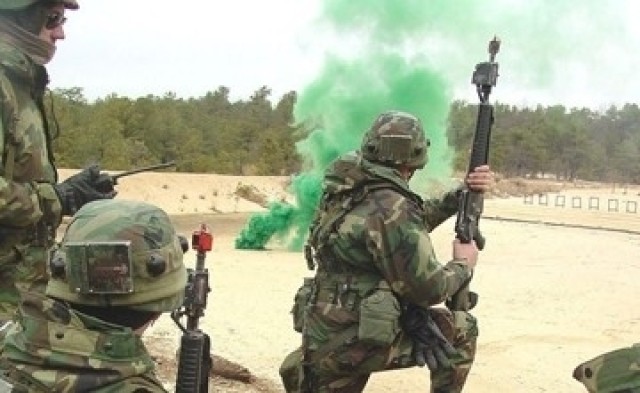PICATINNY ARSENAL, N.J. (Army News Service, May 3, 2007) - Soldiers on the battlefield use colored smoke in a variety of ways - to identify landing zones, friendly troops, potential targets and to communicate with - but it's being overhauled to make it safer for Soldiers and the environment.
"This effort calls for removing potentially harmful dyes and other materials from smoke grenades," said Col. John L. Koster, project manager for Close Combat Systems here. CCS oversees the Army's M18 Smoke Grenade family which comes in green, yellow, red and violet.
The colonel explained that as a grenade ignites, the dye inside vaporizes and condenses to form a colored cloud. The original formulation in most smoke grenades relied on a sulfur-based fuel to generate just enough heat to vaporize the dye.
"The smoke could cause a burning sensation if inhaled, and the dye residue could potentially have a harmful effect on the environment," Col. Koster added.
The colored dyes are undergoing evaluation to determine if lower toxicity dyes can be used in the grenades. Each colored grenade is an independent thermal system and has its own unique problems to solve.
However, the good news is Army scientists have identified numerous possible changes which will remove the sulfur and also reduce weight and manufacturing costs.
"Our scientists came up with a sugar formation to replace the sulfur previously used in most smoke grenades employed by the U.S. military," said Col. Koster. After rigorous testing the result was positive and today, the green and yellow sugar-based mixture versions are currently being used in the field, he said.
But scientists have found changes to the red and violet M18 smoke grenades to be more challenging. The new dyes burned instead of smoked and were not producing enough colored smoke to meet the strict military standards.
The sugar-based smoke compositions burn slightly hotter than the sulfur-based compositions, which result in the newer dyes decomposing rather than vaporizing and exiting the grenades. To keep the new smoke compositions burning long enough to produce the necessary amount of smoke, starter patches are being tested to replace the more complex pellet ignition system.
In addition, the older pellet ignition system had some reliability issues. The change to the starter-patch system makes ignition more reliable because of the increased contact with the smoke composition and the intimate contact greatly increases ignition reliability at colder temperatures.
According to Col. Koster, the violet smoke grenades are nearly complete in meeting the required military standards, but additional testing and development is required to assure a high quality product for Soldiers. The M18 red smoke grenade is in the earlier stages of development and possesses additional challenges to the replacement effort.
For now, pyrotechnic experts say changes to the smoke grenade will make training and deployed scenarios safer for Soldiers as well as help protect and preserve the land on which they train and fight.
(Maj. Keith Taylor serves at Picatinny Arsenal.)


Social Sharing